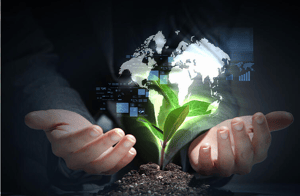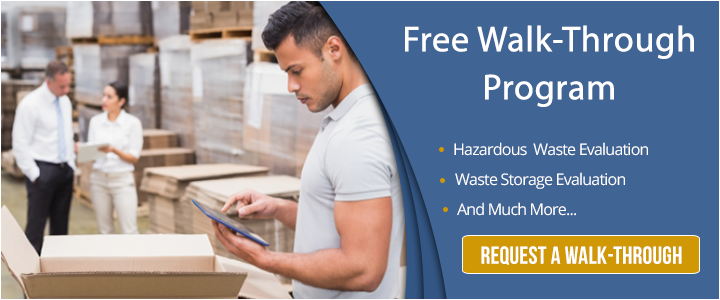There is increasing pressure to reduce the amount of waste filling landfills and to improve recycling capabilities across the globe.
With a focus on zero waste policies, companies and government agencies alike are working on developing solutions that rethink waste management. It’s never been more important as the management of municipal solid waste and hazardous waste has changed substantially.
The generation of municipal solid waste rose from 88.1 million tons in 1960 to 292.4 million tons in 2018, according to the U.S. Environmental Protection Agency. Large quantity generators reported more than 34.9 million tons of hazardous waste in 2019.
In the meantime, a report by the Global Footprint Network has found that the Earth’s natural resources are being used faster than ever.
As businesses and agencies work toward implementing zero waste measures to reduce the burden on natural resources and the amount of waste discarded, here are three trends shaping the zero waste market in 2022 and into the next decade:
- Generating Solutions To The Plastic Problem
- Keeping Organics Out Of Disposal Sites
- Industrial Companies Entering Zero Waste Market
Generating Solutions To The Plastic Problem
Nearly 91% of plastic in the United States goes either to the landfill or ends up contaminating water sources. A World Economic Forum report estimates that without significant changes to how waste is managed, there will be more plastic in the oceans than fish by 2050.
ends up contaminating water sources. A World Economic Forum report estimates that without significant changes to how waste is managed, there will be more plastic in the oceans than fish by 2050.
This issue has caught the attention of several major corporations over the last year, with companies like Starbucks planning to phase out the use of plastic and paper cups by launching a returnable cup program.
States like California, Connecticut, Delaware, Maine, New York and Washington are among those that have banned disposable plastic bags.
Some of the world’s largest companies have also jumped into action, including Coca-Cola, Unliever and PepsiCo. These companies have set targets to achieve 25% recycled content by 2025 by replacing virgin resins with recycled resins.
Nestle has also allocated $1.6 billion that will go toward premiums for recycled materials rather than using virgin plastics. This is among several initiatives toward using more sustainable packaging. The company has announced a goal of 100% recyclable or reusable packaging by 2025. So far, the company says 88% of its total packaging and 62% of its plastic packaging is recyclable or reusable.
New technology is also being developed to help achieve a zero-waste market. Cat-HTR™ technology, or catalytic hydrothermal reactor, is an advanced recycling process that uses supercritical steam to convert plastics back into the chemicals and oils from which they were made.
This technology can recycle all plastic waste, including many types of packaging like pots and trays that are currently incinerated or sent to landfills because they are difficult to recycle.
The push to remove plastics from landfills has also caught the attention of federal regulators. The U.S. Environmental Protection Agency is currently evaluating whether polyvinyl chloride constitutes hazardous waste under federal law.
The agreement is in response to a 2021 lawsuit by the Center for Biological Diversity, which argues that the EPA should regulate PVC as hazardous waste under the Resource Conservation and Recovery Act (RCRA). The organization says studies show that PVC damages the environment. This type of plastic is often used in toys, medical equipment and construction materials.
Suppose the EPA determines that PVC should fall under hazardous waste laws. In that case, it’s likely many companies and industries will need to update their waste management plans to include procedures for safely and legally disposing of this type of plastic. According to the agreement, a decision is expected later this year or in early 2023.
You can read more about this latest development in our article, EPA Move To Regulate PVC As Hazardous Waste.
Keeping Organics Out Of Disposal Sites
While much of the United States has not put into motion an organics collection process, some states are expanding policies to ensure food, paper products and other types of organic waste stay out of landfills.
collection process, some states are expanding policies to ensure food, paper products and other types of organic waste stay out of landfills.
California Senate Bill 1383, which went into effect at the beginning of this year (2022), requires that businesses and residents separate organic materials from their trash. Passed in 2016, the measure aims to reduce greenhouse gas emissions from landfills.
The California bill falls in line with the U.S. Environmental Protection Agency’s 2030 food waste goal to cut food loss and waste by 50%. The U.S. Department of Agriculture estimates that in 2010, food loss accounted for 31% of the food supply, equaling 133 billion pounds at an estimated value of $161.6 billion. The 2030 goal aims to cut food loss in half or by about 66 billion pounds.
In addition to focusing on food waste, the California bill requires that businesses begin separating other types of organic waste from trash and recycling. These materials include:
- Landscape waste
- Wood
- Paper products
- Manure
- Organic textiles
The law gives local and county jurisdictions until 2024 to implement organic collection services for businesses and residences, similar to how trash and recycling are collected now.
Other states like Connecticut, Massachusetts and New York have also expanded their waste policies to help keep organics out of disposal sites. For example, Connecticut requires businesses that produce large amounts of food waste to recycle it if they are within 20 miles of a facility that is licensed by the state to accept it.
In New York, the NYS Food Donation and Food Scraps Recycling law requires businesses and institutions that generate an annual average of 2 tons of wasted food per week or more to donate excess edible food and recycle any remaining food scraps if they are located within 25 miles of an organics recycler. This law went into effect on Jan. 1, 2022.
As trends point to more states implementing policies to reduce food waste, we may see more and more organics recycling fit in with overall zero waste goals at both the micro and macro levels.
You can read more about this new law in our article, What Does The New California Organic Waste Law Mean For Your Business?
Industrial Companies Entering Zero Waste Market
Manufacturers often overlook opportunities for achieving zero waste because the type of waste they produce is hazardous. Hazardous waste is subject to much stronger regulations that require specialized hazardous waste disposal.
because the type of waste they produce is hazardous. Hazardous waste is subject to much stronger regulations that require specialized hazardous waste disposal.
Yet more manufacturing companies are discovering the benefits of recycling waste, especially if they produce industrial solvents.
Solvents are molecules that can dissolve other molecules, known as solutes. A solvent can be solid, liquid or gas. Some of the most commonly recycled solvents in the industry include aromatics, halogenated hydrocarbons, alcohols, ketones, and esters.
As more companies this year work toward improving their sustainability efforts while lowering costs, many are instead turning toward solvent distillation as a way to achieve zero waste.
After a hazardous waste disposal company transports solvent waste to a solvent distillation facility, this process separates a liquid or vapor mixture of two or more substances into its component fractions of desired purity. After the vapor cools and condenses, the liquid condensate is ready to be sold back into the industry.
If there are any portions of the original mixture that do not vaporize, these are not discarded. Instead, these remains are recovered and used as an alternative fuel source for other industries. In other words, there is ZERO WASTE left during the solvent distillation process.
Help Incorporating These Trends Into Your Waste Solutions
As you consider how your company can better incorporate environmentally-friendly waste management practices into everyday business, an experienced hazardous waste disposal company can help.
The best disposal companies will offer a walk-through program to evaluate your waste procedures to ensure they are environmentally friendly and help you look for ways to reduce waste. This program is consultative in nature and helps ensure you are operating in compliance with state and federal laws.
A walk-through is NOT an audit of your operations. It’s a collaborative effort to determine what potential issues need to be addressed and help you reach the sustainability goals you want to achieve.
While the above three trends are helping to shape the zero waste market this year and in the coming years, it’s important to keep in mind that there are several ways your business can improve its sustainability by how you handle the hazardous waste you generate.
An experienced and licensed hazardous waste disposal company can help by not only transporting your waste to the appropriate recycling and disposal sites but by working with you to ensure the footprint your company leaves aligns with your company’s goals and values.


Comment